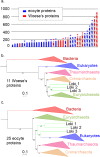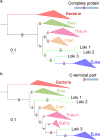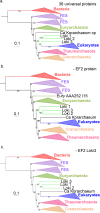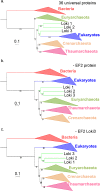Lokiarchaea are close relatives of Euryarchaeota, not bridging the gap between prokaryotes and eukaryotes
- PMID: 28604769
- PMCID: PMC5484517
- DOI: 10.1371/journal.pgen.1006810
Lokiarchaea are close relatives of Euryarchaeota, not bridging the gap between prokaryotes and eukaryotes
Abstract
The eocyte hypothesis, in which Eukarya emerged from within Archaea, has been boosted by the description of a new candidate archaeal phylum, "Lokiarchaeota", from metagenomic data. Eukarya branch within Lokiarchaeota in a tree reconstructed from the concatenation of 36 universal proteins. However, individual phylogenies revealed that lokiarchaeal proteins sequences have different evolutionary histories. The individual markers phylogenies revealed at least two subsets of proteins, either supporting the Woese or the Eocyte tree of life. Strikingly, removal of a single protein, the elongation factor EF2, is sufficient to break the Eukaryotes-Lokiarchaea affiliation. Our analysis suggests that the three lokiarchaeal EF2 proteins have a chimeric organization that could be due to contamination and/or homologous recombination with patches of eukaryotic sequences. A robust phylogenetic analysis of RNA polymerases with a new dataset indicates that Lokiarchaeota and related phyla of the Asgard superphylum are sister group to Euryarchaeota, not to Eukarya, and supports the monophyly of Archaea with their rooting in the branch leading to Thaumarchaeota.
Conflict of interest statement
The authors have declared that no competing interests exist.
Figures








Comment in
-
Asgard archaea are the closest prokaryotic relatives of eukaryotes.PLoS Genet. 2018 Mar 29;14(3):e1007080. doi: 10.1371/journal.pgen.1007080. eCollection 2018 Mar. PLoS Genet. 2018. PMID: 29596421 Free PMC article. No abstract available.
-
Asgard archaea do not close the debate about the universal tree of life topology.PLoS Genet. 2018 Mar 29;14(3):e1007215. doi: 10.1371/journal.pgen.1007215. eCollection 2018 Mar. PLoS Genet. 2018. PMID: 29596428 Free PMC article. No abstract available.
-
The trickster microbes that are shaking up the tree of life.Nature. 2019 May;569(7756):322-324. doi: 10.1038/d41586-019-01496-w. Nature. 2019. PMID: 31089235 No abstract available.
References
-
- Embley TM, Martin W. Eukaryotic evolution, changes and challenges. Nature. 2006;440: 623–630. doi: 10.1038/nature04546 - DOI - PubMed
-
- Criscuolo A, Gribaldo S. BMGE (Block Mapping and Gathering with Entropy): a new software for selection of phylogenetic informative regions from multiple sequence alignments. BMC Evol Biol. 2010;10: 210 doi: 10.1186/1471-2148-10-210 - DOI - PMC - PubMed
-
- Martijn J, Ettema TJG. From archaeon to eukaryote: the evolutionary dark ages of the eukaryotic cell. Biochem Soc Trans. 2013;41: 451–7. doi: 10.1042/BST20120292 - DOI - PubMed
-
- Forterre P. The common ancestor of archaea and eukarya was not an archaeon. Archaea. 2013;2013 doi: 10.1155/2013/372396 - DOI - PMC - PubMed
-
- Forterre P. The universal tree of life: An update. Front Microbiol. 2015;6: 1–18. doi: 10.3389/fmicb.2015.00717 - DOI - PMC - PubMed
MeSH terms
Substances
Grants and funding
LinkOut - more resources
Full Text Sources
Other Literature Sources
Miscellaneous

